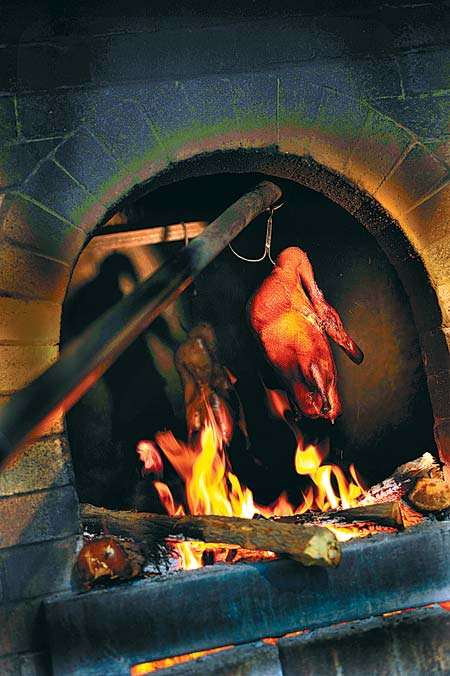Just ducky
Updated: 2012-03-24 07:46
By Ye Jun (China Daily)
|
|||||||||||
I had two questions on my mind before visiting 1949 Jinbao Jie, Duck de Chine's second branch in Beijing. How grand would the interior decor be, I was thinking, given its location on one of the city's most expensive streets?
Then, owners of the restaurant must be very confident of their Peking roast duck, because they are just a stone's throw away from Da Dong's Jinbao Jie branch, another popular restaurant famous for its roast duck. So how was it?
As I walked through the restaurant to my table, I instantly fell in love with the ambience.
In Chinese architecture, there is nothing more comfortable than a courtyard house, which is designed to connect the energy between heaven and earth. The restaurant 1949 Jinbao Jie is adapted from such a courtyard house, and one can look at an open space with beautifully painted eaves and columns around, from two main dining areas, and from the bar.
The central dining area also has a view of a piece of lawn dotted with bronze sculptures. All the areas have French windows, allowing maximum natural light. It would be very relaxing to sit lazily at one of the tables, over a cup of tea, on one of Beijing's sunny spring days.
|
 A duck is roasted in one of three open brick ovens at 1949 Jinbao Jie |
I actually ventured to ask for a cup of raw pu'er, because I know most restaurants in town only serve snack-food quality mature pu'er. But the cup of Yunnan raw pu'er I got was of surprisingly high quality.
Two interesting details attracted me at the table - a lovely Cloisonne duck-shaped chopstick holder and a flat bottle of XO sauce. Once a customer liked the chopstick holder so much that he offered 300 yuan ($47) to buy it, according to Sarah Li, the restaurant's director of sales and marketing. The abundant bottle of XO sauce is free. But if you finish it and ask for another bottle, it will cost you 128 yuan ($20).
The duck proved to be really good. The skin is not particularly crisp, but it is easy to chew, not leaving hard fiber in the mouth. When you dip the duck in sauce and roll it up in a pancake, along with shallot, turnip and cucumber slices, it is very tasty.
I think it is safe to say it is one of Beijing's best roast duck. Hollow sesame cakes you can put duck inside also taste good, but not as good as the traditional pancakes with duck.
The duck comes from Beijing Jinxing duck plant, which also supplies ducks for Quanjude and Da Dong.
| ||||
Chefs roast the ducks at three open brick ovens at one side of the restaurant. Ducks are roasted for 65 minutes. The firewood used is more than 40-year-old jujube wood from Shaanxi and Shanxi provinces, which is hard and smokeless, according to the restaurant. If you reserve in advance, the restaurant can serve your duck 20 minutes after arrival.
When served, the fat below the skin is taken out, and the duck is cut into a square shape, besides a long shape, to fit perfectly into the round sesame cake, or into the steamed pancake wrapping.
Duck-liver terrine on toast is a must-try. Vegetarian "roast goose" (steamed bean curd skin with diced mushroom) is another delicious and healthy appetizer.
We tried the restaurant spring special, a fresh sauteed sliced whelk with asparagus and mushrooms, and a very tender and soft steamed fish head. Both are recommended.
The fish head has quite a few bones but is a favorite among Chinese customers. The restaurant's Cantonese dim sum - shrimp dumpling and pork and fish roe shaomai - are tasty winners. Double-boiled fresh milk with ginger is a very nice dessert.
The interior decor seems modern, but it's dotted with plenty of Chinese elements, such as beautiful red lanterns, and big paintings of duck and lotus on the walls. A series of martial arts statues along the doorway are quite pleasing. Outdoors, the lighting is carefully designed to make the restaurant look even better at night.
Our saucers were changed three times during the lunch, making the 10 percent service fee seem worth it. The average bill is around 400 yuan ($63) per person for a full meal, although you can spend from 150-300 yuan per head for a simpler meal of dim sum and soup.
Contact the writer at yejun@chinadaily.com.cn.
Today's Top News
Rescuers race against time for quake victims
Telecom workers restore links
Coal mine blast kills 18 in Jilin
Intl scholarship puts China on the map
More bird flu patients discharged
Gold loses sheen, but still a safe bet
US 'turns blind eye to human rights'
Telecom workers restore links
Hot Topics
Lunar probe , China growth forecasts, Emission rules get tougher, China seen through 'colored lens', International board,
Editor's Picks

|

|

|

|

|

|





